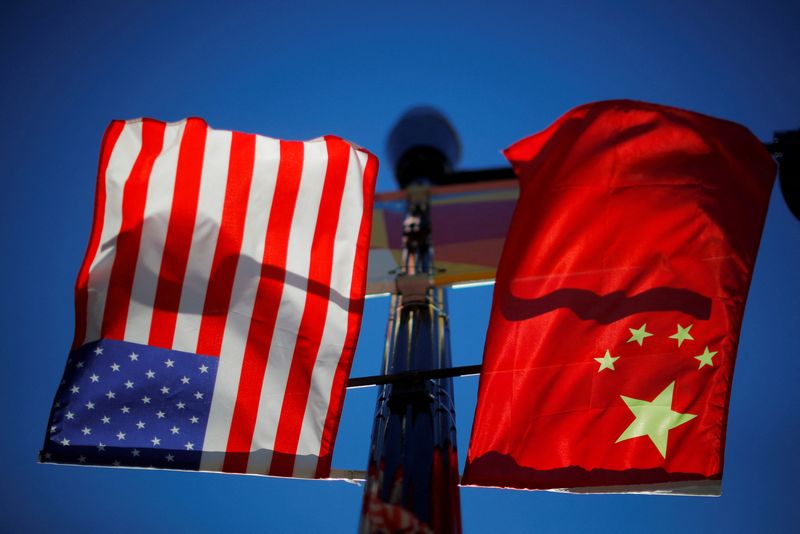By Jamie McGeever
ORLANDO, Florida (Reuters) -A gradual financial disentangling of China and the United States after decades of symbiosis may reduce fears of 'mutually assured financial destruction' but also harden divisions in an increasingly polar global economy.
Whether one or the other suffers more from that separation is under the microscope right now. But the mutual threat - especially China's U.S. bond holdings - looks far less potent than once assumed.
Since China's return to the global economic stage in 2000, the wave of U.S. corporate and banking investment in the country was seemingly matched by China banking windfall savings from the resulting export and growth boom back into U.S. Treasury bonds.
Channeling the old Cold War thesis of a stable nuclear arms rivalry, some saw 'MAFD' and the resulting inter-dependence as binding the two together and preventing any sudden fracture in the economic relationship.
The circular thinking was that any political standoff that disturbed those investment flows would be so devastating to both in the highly integrated world economy that they would always step back from the brink.
But that's not quite how it has panned out.
Following the trade wars of late 2010s, the pandemic shock and geopolitical rifts surrounding Ukraine and Taiwan, both sides have substantially reduced their respective financial footprints in the other. "Derisking," in Washington parlance.
While its debatable to what extent China's current deep market disturbance is related to the rapid retreat of U.S. corporate and banking investment over the past two years, China's hold on the U.S. bond market has loosened too.
The latest figures show China held $782 billion of Treasuries in November - a large amount, but also around its smallest in 15 years and down significantly from the peaks of $1.3 trillion in 2011 and 2013.
More importantly, China's footprint in the U.S. bond market is a fraction of what it once was. China owns less than 3% of all outstanding Treasuries, the smallest share in 22 years, and again substantially down from the record 14% in 2011.
Granted, China also likely holds Treasuries via other countries like Belgium. And an estimated 60% of China's $3.24 trillion foreign reserves is in other dollar-denominated assets like agency bonds, shorter-term bills, and bank deposits.
But Beijing's influence over the U.S. bond market has waned.
"China's holdings are large enough that selling could in theory be very disruptive, although its hold over the market is not what it was relative to the past," notes Alan Ruskin, macro strategist at Deutsche Bank.
"But China has not shown any desire to be a disruptive force in this regard."
DECOUPLING
China is not alone. The rise in overseas holdings of Treasuries to all-time highs of around $6.8 trillion is down to the private sector - global official holdings have fallen to a 12-year low around $3.4 trillion.
The Treasury market is now a $26 trillion beast, twice as large as it was eight years ago and five times its size before Lehman Brothers collapsed in 2008.
But China has steadily lagged its central bank peers, and Beijing's share of all Treasuries owned by the official sector is now 21%. That's the lowest since 2005, and well below the peak of 37.5% in 2011.
There are signs that outright selling as well as valuation adjustments is shrinking China's Treasuries portfolio.
Deutsche Bank's Ruskin estimates that China sold $15 billion in November, taking net selling over the last 12 months to $65 billion, flows that will support the notion that China is "decoupling from a key financial linkage with the US."
GO WITH THE FLOW
It is difficult to accurately track bilateral U.S.-China capital flows. Chinese companies list on non-Chinese exchanges, U.S. investors funnel funds into China via offshore financial centers, and there is the huge difference in liquidity and accessibility of Chinese 'A' shares and 'H' shares.
But broad measures suggest the decoupling is going both ways.
In the first nine months of last year U.S. investors sold a net $1.76 billion of Chinese financial assets, according to official U.S. quarterly balance of payments data. That was largely driven by equity selling.
In calendar year 2022 they sold a net $9.5 billion of Chinese assets and the year before that they sold a whopping $67 billion. Both were driven by powerful equity outflows.
U.S. companies have been pulling money out of China too.
Official U.S. balance of payments data show that a net $5.6 billion of direct investment flowed back to the United States in the first nine months of last year, and in calendar year 2022 that flow totaled $12 billion.
This tallies with China recording an $11.8 billion deficit in foreign direct investment in the third quarter last year, its first ever FDI deficit with the rest of the world. That was a marker.
The United States and China start 2024 on very different financial and economic footings - the S&P 500 is at a record high; U.S. market outperformance over Chinese stocks is yawning; nominal U.S. GDP growth last year was probably higher than China's; global money is flooding out of China and into America.

As their financial co-dependence diminishes, China appears to be the more vulnerable of the two. Not what everyone would have predicted 20 years ago.
(The opinions expressed here are those of the author, a columnist for Reuters.)
(By Jamie McGeever; Editing by Andrea Ricci)